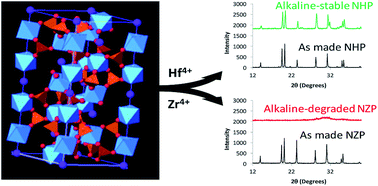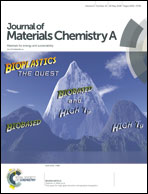Enhanced alkaline stability in a hafnium-substituted NaSICON ion conductor†
Abstract
We present here a multi-length scale integration of compositionally tailored NaSICON-based Na+ conductors to create a high Na+ conductivity system resistant to chemical attack in strongly alkaline aqueous environments. Using the Pourbaix Atlas as a generalized guide to chemical stability, we identify NaHf2P3O12 (NHP) as a candidate NaSICON material for enhanced chemical stability at pH > 12, and demonstrate the stability of NHP powders under accelerated aging conditions of 80 °C and pH = 13–15 for a variety of alkali metal cations. To compensate for the relatively low ionic conductivity of NHP, we develop a new low temperature (775 °C) alkoxide-based solution deposition chemistry to apply dense NHP thin films onto both platinized silicon wafers and bulk, high Na+ conductivity Na3Zr2Si2PO12 (NZSP) pellets. These NHP films display Na+ conductivities of 1.35 × 10−5 S cm−1 at 200 °C and an activation energy of 0.53 eV, similar to literature reports for bulk NHP pellets. Under aggressive conditions of 10 M KOH at 80 °C, NHP thin films successfully served as an alkaline-resistant barrier, extending the lifetime of NZSP pellets from 4.26 to 36.0 h. This integration of compositionally distinct Na+ conductors across disparate length scales (nm, mm) and processing techniques (chemically-derived, traditional powder) represents a promising new avenue by which Na+ conducting systems may be utilized in alkaline environments previously thought incompatible with ceramic Na+ conductors.

- This article is part of the themed collection: Industry R&D collection


 Please wait while we load your content...
Please wait while we load your content...